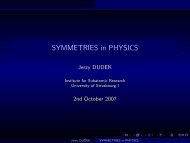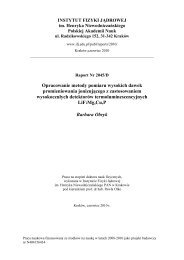GlowFit â a new tool for thermoluminescence glow curves doconvo
GlowFit â a new tool for thermoluminescence glow curves doconvo
GlowFit â a new tool for thermoluminescence glow curves doconvo
You also want an ePaper? Increase the reach of your titles
YUMPU automatically turns print PDFs into web optimized ePapers that Google loves.
Table 1. Comparison of FOM [%] values obtained using <strong>GlowFit</strong> with FOM values obtained<br />
within the GLOCANIN intercomparison project [taken from Reference 6].<br />
File name<br />
<strong>GlowFit</strong><br />
FOM<br />
GLOCANIN<br />
Program B (6)<br />
FOM<br />
RefGlow.001 0.010 0.010<br />
RefGlow.002 0.010 0.010<br />
RefGlow.003 1.180 1.150<br />
RefGlow.004 1.060 1.100<br />
RefGlow.005 1.040 1.070<br />
RefGlow.006 1.230 1.270<br />
RefGlow.007 1.000 0.950<br />
RefGlow.008 0.920 1.130<br />
RefGlow.009 1.350 1.700<br />
RefGlow.010 3.860 4.120<br />
Table 2 shows a comparison between the activation energy obtained by <strong>GlowFit</strong> analysis with<br />
the actual activation energies of the GLOCANIN project <strong>for</strong> synthetic and average <strong>for</strong><br />
experimental <strong>glow</strong>-<strong>curves</strong>. Agreement <strong>for</strong> the synthetic <strong>glow</strong>-<strong>curves</strong> is within 0.09% or less.<br />
These results are rather natural because the data were simulated using the Randall-Wilkins<br />
model, the same that was used to develop the <strong>GlowFit</strong> software. Analysis was per<strong>for</strong>med<br />
without any pattern file and without setting any constraints. The percentage deviation between<br />
the mean activation energies of the GLOCANIN project and activation energies obtained<br />
using the <strong>GlowFit</strong> is below 6%.<br />
Table 2. Percentage deviation between the activation energies of the GLOCANIN project and<br />
activation energies obtained using the <strong>GlowFit</strong> <strong>for</strong> synthetic and the experimental reference<br />
<strong>glow</strong>-<strong>curves</strong>.<br />
Percentage deviation<br />
File name Peak 1 Peak 2 Peak 3 Peak 4 Peak 5<br />
Synthetic reference <strong>glow</strong>-<strong>curves</strong><br />
RefGlow.001 0.02<br />
RefGlow.002 0.04 0.05 0.03 0.09<br />
RefGlow.003<br />
RefGlow.004<br />
RefGlow.005<br />
RefGlow.006<br />
RefGlow.007<br />
RefGlow.008<br />
RefGlow.009<br />
RefGlow.010<br />
Experimental reference <strong>glow</strong>-<strong>curves</strong><br />
5.6 2.6 1.2 0.8<br />
5.7 1.7 2.5 2.4<br />
1.2 0.2 3.4 0.6<br />
2.4 1.3 2.3 1.3<br />
4.2 0.3 1.5<br />
1.5 0.6 0.6<br />
0.3 0.2 1.3 3.7<br />
0.6 1.1 5.9 2.1<br />
The most complicated <strong>glow</strong>-curve was RefGlow.009, measured <strong>for</strong> LiF:Mg,Ti irradiated with<br />
a dose of 600Gy, which shows a complex structure over high-temperature peak region. These<br />
overlapping peaks make the fitting procedure quite difficult. The GLOCANIN participants’<br />
results differed not only in the position and shape of resolved peaks but also in their number<br />
(9 or 10). Because there are several possibilities of obtaining a good fit, it is not surprising that<br />
a great spread, up to 60%, in peak areas and activation energies was found. This complex<br />
<strong>glow</strong>-curve presented in Figure 1 shows how important it is to be able occasionally to<br />
introduce parameter constraints to the fit. If peaks strongly overlap, the fitting procedure is<br />
evidently not so unequivocal, so in<strong>for</strong>mation about the peak’s position and about other<br />
5
















